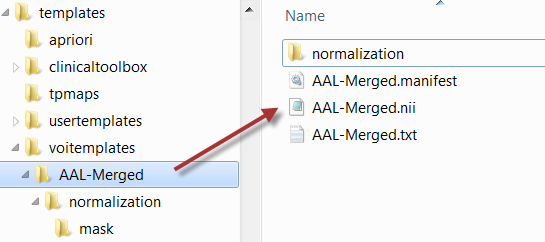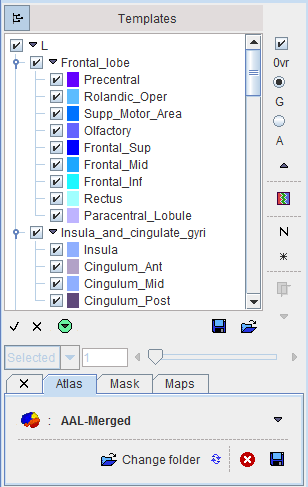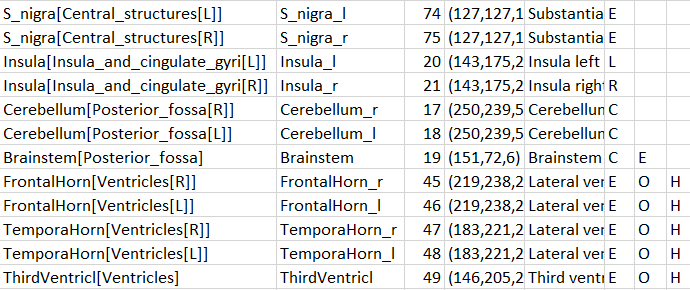A VOI atlas in PMOD consists of the following components:
SPECIES = HUMANAPPLICATION = NO_PNEUROTYPE = PROBABILISTIC, RANGE 0 / 100The space definition is applicable only for the human species:
SPACE = MNI
This information has to be organized in a subdirectory of resources/templates/voitemplates in a particular way as illustrated below.

The atlas name (e.g. AAL-Merged) has to be used as the name of the sub-directory, the atlas image (AAL-Merged.nii), the label list (AAL-Merged.txt), and the manifest (AAL-Merged.manifest).
By conforming to this structure it is possible for users to prepare their own VOI atlases. Note however, that in PNEURO they are only applicable for Maximum Probability Atlas approach, not for the Brain Parcellation approach.
Atlas Image
The atlas image must be prepared as a NifTI file and encode the atlas VOIs as numeric labels. Each pixel has a value of 0 if it is a background pixel, or otherwise an integer number. We recommend using the HFS anatomical orientation (head first, supine = radiological convention) for human data.
Label List
The label list text file has the minimal form: name1 outlined_name1 label_value1name2 outlined_name2 label_value2
where each VOI is represented by a line.
The list can be extended with additional information for the VOI presentation as illustrated below for the AAL-Merged.txt. The first column starts with the name followed by a bracket construction which encodes a tree structure. For instance, Precentral belongs to the Frontal_Lobe which is located in the left L or right R hemisphere. The second column indicates the name of a generated contour VOI. The third column contains the label value in the atlas file. Each pixel in AAL-Merged.nii with value 1 will belong the Precentral_l VOI, pixels with value 2 to Precentral_l, etc. The third column specifies the RGB color values for showing the VOI, and the last column the text to be shown as a tooltip.

The corresponding atlas VOI structure is illustrated below.

There are additional options to be added in the columns for use in PNEURO:
Example as shown in Excel:

Spatial Normalization
Atlases can only be applied to images if they have the same resolution and show the anatomy with the same geometry. Therefore, images originating from real experiments first need a normalization step for the atlas to be applied. This is done by calculating a normalization transform between the subject image and a "template" image representing the standard anatomy imaged with a certain modality, and using it for warping the VOIs to the subject anatomy.
Name of method in PMOD |
Methodology and template |
Template-based normalization |
Implementation of the spatial normalization in SPM5. It requires a template image in the atlas space which has a similar pattern as the image to normalize. The usual reference images are the PET, T1 and T2 SPM5 templates. |
3 Probability maps normalization |
Implementation of the unified segmentation normalization in SPM8. It requires tissue probability maps of grey matter, white matter and CSF in the atlas space, which is organized in a dynamic file called tpm.nii. This normalization is mostly applicable to T1-weighted MR images. |
6 Probability maps normalization |
Implementation of the unified segmentation normalization in SPM12. It uses three additional probability maps (bone, tissue and air), which are organized in a dynamic file tpm_6.nii. |
Template Normalization Files
Appropriate template images for the Template-based normalization (SPM5) need to be copied to a normalization sub-folder.
The normalization folder of a user define atlas contains two templates: the T1 MR and the PET. The templates show the anatomy in the space in which the VOIs atlas was define. The atlas name (e.g. BRAIN_AAL_Merged) has to be used as the root name for the templates followed by the suffixes -MR (BRAIN_ALL_Merged-MR.nii) and -PET (BRAIN_ALL_Merged-PET.nii) for the MR and PET template respectively.

The normalization works best if the information is restricted to the relevant image part. Therefore, normalization should contain a mask sub-folder with a mask file mask.nii containing 1 for all relevant pixels and 0 for all others.
Probability Normalization Files
The normalization files for the two probability maps approaches need to be prepared in a normalization/tmp subdirectory as illustrated below.

Note: The human brain atlases for which the manifest file contains SPECIES = HUMAN and SPACE = MNI definitions do not require the preparation of the normalization subdirectory. In such cases the universal MNI files for the human brain available in the template and the tpmaps directories will be used.